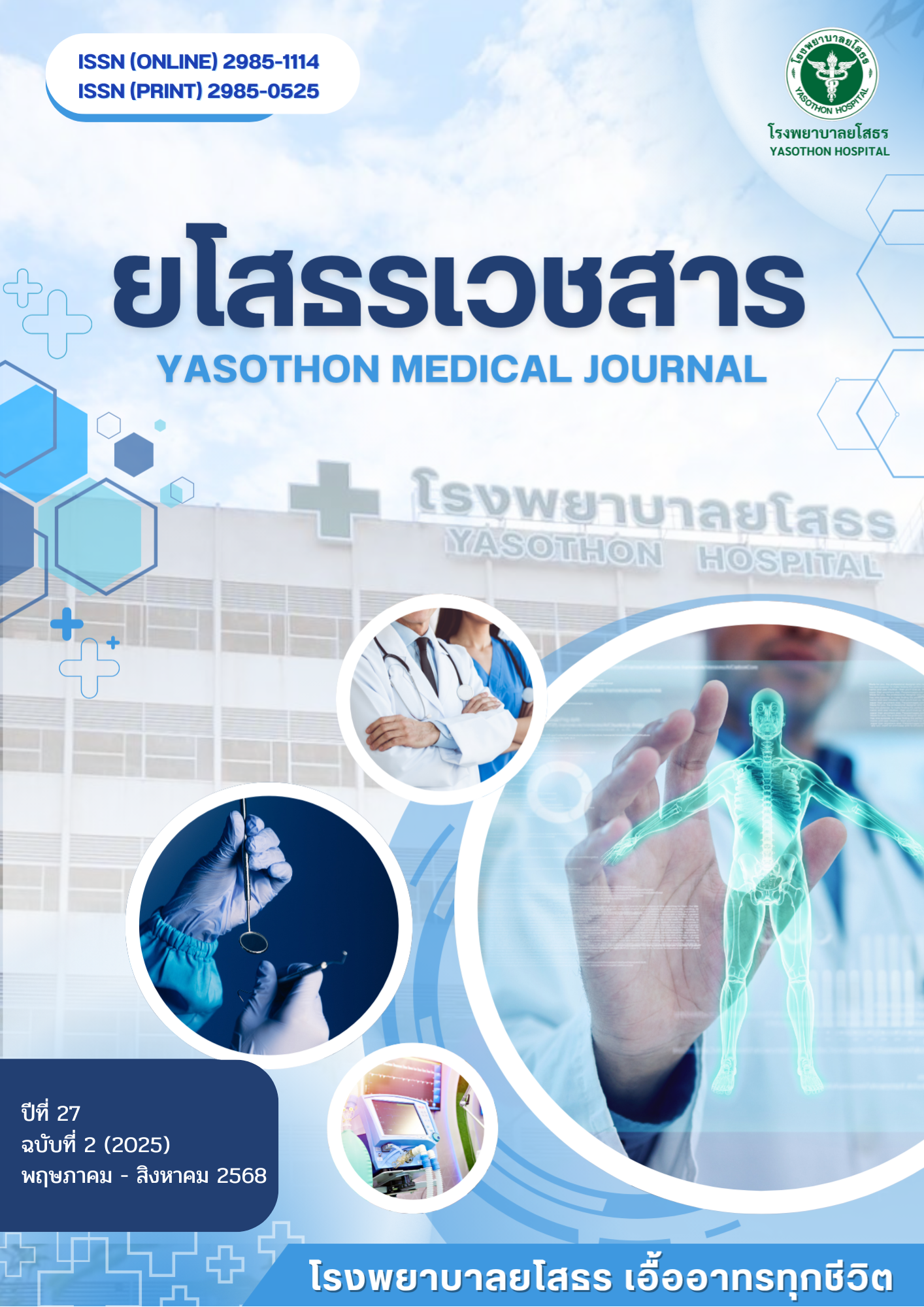Development of a Community-Based Larval Control Model for the Prevention of Aedes-Borne Diseases through Network Stakeholder Participation in Yasothon Municipality, Yasothon, Thailand
Keywords:
Larval Control, Aedes Mosquitoes, Community Participation, Participatory Action Research, BANTHA ModelAbstract
The persistent outbreaks of dengue fever and other mosquito-borne diseases remain a critical public health issue in Thailand, particularly in urban areas where environmental conditions facilitate Aedes mosquito breeding. This study aimed to develop a sustainable community-based larval control model for disease prevention through participatory engagement of network stakeholders in Yasothon Municipality, Yasothon Province. A Participatory Action Research (PAR) approach was employed, guided by the P-A-O-R cycle: Planning, Action, Observation, and Reflection. The target participants included two main stakeholder groups: (1) 53 representatives from local government, health, and education sectors across 23 communities, and (2) 148 members of community-based organizations, such as village health volunteers and community committee members. Both quantitative and qualitative data were collected and analyzed using descriptive statistics, paired t-tests, and content analysis. Findings revealed that the implementation of the BANTHA Model, comprising Brainstorming (B), Agreement (A), Network (N), Teamwork (T), Hygiene (H), and Acceptance (A), led to statistically significant improvements in three key areas: knowledge of Aedes-borne disease prevention and control (p < 0.001), level of community participation (p < 0.001), and satisfaction with the implemented activities (p < 0.001). Additionally, entomological indices, House Index (HI), Container Index (CI), and Breteau Index (BI), showed significant reductions (p < 0.001) following model implementation. In conclusion, this research demonstrates the capacity of local communities to effectively and sustainably prevent mosquito-borne diseases when empowered through structured participatory mechanisms. The BANTHA model offers a promising framework for scalable public health policy and community-based vector control strategies at the national level.
Keywords: larval control, Aedes mosquitoes, community participation, participatory action research, BANTHA model
References
กองโรคติดต่อนำโดยแมลง กรมควบคุมโรค. โรคไข้เลือดออก. นนทบุรี: กระทรวงสาธารณสุข; 2566.
กรมควบคุมโรค สถาบันป้องกันควบคุมโรคเขตเมือง. แนวทางการเฝ้าระวัง ป้องกันควบคุมโรคไข้เลือดออกในเขตเมือง Urban Dengue Unit Guideline. กรุงเทพฯ: โรงพิมพ์ชุมนุมสหกรณ์การเกษตรแห่งประเทศไทย; 2561.
กองโรคติดต่อนำโดยยุงลาย กรมควบคุมโรค. รายงานสถานการณ์โรคไข้เลือดออก พ.ศ. 2566 [อินเตอร์เน็ต]. 2566 [เข้าถึงเมื่อ 1 พฤษภาคม 2568]. เข้าถึงได้จาก: https://www.tessabantambonbor.go.th/contents/post/000000385-
a63602b02cd7a544d733b729cf7108e.pdf
กลุ่มงานควบคุมโรคติดต่อ. สถานการณ์โรคไข้เลือดออก จังหวัดยโสธร ปี 2566. ยโสธร: สำนักงานสาธารณสุขจังหวัดยโสธร; 2566.
อรุณรัศม์ แสนบุญรัตน์, ฉันทนา อนุฤทธิ์, ขวัญเรือน บุญศรี. แนวทางการค้นหาปัญหาโรคไข้เลือดออก ชุมชนสามัคคีเทศบาลเมืองมหาสารคาม [วิทยานิพนธ์ปริญญาสาธารณสุขศาสตร์มหาบัณฑิต]. มหาสารคาม: มหาวิทยาลัยมหาสารคาม; 2552.
วรวิทย์ วุฒา. การพัฒนาระบบการเฝ้าระวังและควบคุมไข้เลือดออกในพื้นที่อำเภอธาตุพนม จังหวัดนครพนม. วารสารสำนักงานป้องกันควบคุมโรคที่ 10 มกราคม-มิถุนายน 2561; 16(1): 51–62.
กฤษฎา โยธารักษ์. การรับรู้และการมีส่วนร่วมของประชาชนในการป้องกันและควบคุมโรคไข้เลือดออกในหมู่บ้านที่พบอุบัติการณ์โรคสูงและอุบัติการณ์โรคต่ำ อำเภอเฉลิมพระเกียรติ จังหวัดนครศรีธรรมราช ปี พ.ศ. 2553 [วิทยานิพนธ์ปริญญาสาธารณสุขศาสตรมหาบัณฑิต]. นครศรีธรรมราช: มหาวิทยาลัยวลัยลักษณ์; 2554.
กฤตย์ติวัฒน์ ฉัตรทอง. การพัฒนารูปแบบการป้องกันโรคไข้เลือดออกในชุมชนนาชะอัง จังหวัดชุมพร [วิทยานิพนธ์ปริญญาวิทยาศาสตรดุษฎีบัณฑิต]. กรุงเทพฯ: มหาวิทยาลัยศรีนครินทร์วิโรฒ; 2553.
ธนกร จีระออน. รูปแบบการป้องกันโรคไข้เลือดออกในระดับชุมชนจังหวัดบุรีรัมย์ [วิทยานิพนธ์ปริญญาสาธารณสุขศาสตรมหาบัณฑิต]. มหาสารคาม: มหาวิทยาลัยมหาสารคาม; 2553.
Downloads
Published
Versions
- 2025-11-14 (3)
- 2025-11-14 (2)
- 2025-09-24 (1)
How to Cite
Issue
Section
License
Copyright (c) 2025 YASOTHON MEDICAL JOURNAL

This work is licensed under a Creative Commons Attribution-NonCommercial-NoDerivatives 4.0 International License.
บทความที่ได้รับการตีพิมพ์เป็นลิขสิทธิ์ของยโสธรเวชสาร







